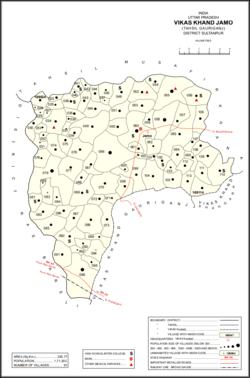Gaura, Jamo
Gaura | |
|---|---|
Village | |
 Map showing Gaura (#052) in Jamo CD block | |
| Coordinates: 26°24′03″N 81°40′33″E / 26.400771°N 81.675882°E[1] | |
| Country | |
| State | Uttar Pradesh |
| Division | Faizabad division |
| District | Amethi |
| Area | |
• Total | 4.887 km2 (1.887 sq mi) |
| Population (2011)[2] | |
• Total | 4,349 |
| • Density | 890/km2 (2,300/sq mi) |
| Languages | |
| • Official | Hindi, Urdu |
| Time zone | UTC+5:30 (IST) |
Gaura is a village in Jamo block of Amethi district, Uttar Pradesh, India.[2] The namesake of the historical pargana of Gaura Jamun, Gaura consists of a main site called Gaura khas in the northeast surrounded by several smaller hamlets.[3] The village lands are fertile and contain many orchard groves.[3] In the east-central part there is a large jhil which provides a convenient source of irrigation but also sometimes overflows and floods the surrounding fields.[3] Gaura is located just north of Jamo on the Gauriganj-Jagdishpur road, and another road also leads off to Musafirkhana.[3]
As of 2011, Gaura has a population of 4,349 people, in 700 households.[2] It has 3 primary schools and a family welfare centre and it does not host a regular market or weekly haat.[2] It serves as the seat of a nyaya panchayat which also includes 6 other villages.[4]
History
[edit]At the turn of the 20th century, Gaura was described as a fairly large but otherwise rather insignificant village that belonged to the taluqdari estate of Katari.[3] It had a primary school, and an area of high nazul land indicated that there also used to be a fort here.[3] As of 1901, Gaura's population was 1,448 people, of which the majority were Ahirs and also including a Muslim minority of 131.[3]
The 1951 census recorded Gaura as comprising 17 hamlets, with a total population of 1,731 people (824 male and 907 female), in 368 households and 366 physical houses.[5] The area of the village was given as 1,282 acres.[5] 146 residents were literate, 126 male and 20 female.[5] The village was listed as belonging to the pargana of Gaura Jamo and the thana of Jagdishpur.[5] The village had a district board-run primary school with 177 students in attendance as of 1 January 1951.[5]
The 1961 census recorded Gaura as comprising 22 hamlets, with a total population of 1,770 people (889 male and 881 female), in 381 households and 356 physical houses.[6] The area of the village was given as 1,282 acres and it had a post office at that point.[6]
The 1981 census recorded Gaura as having a population of 2,557 people, in 465 households, and having an area of 518.83 hectares.[7] The main staple foods were listed as wheat and rice.[7]
The 1991 census recorded Gaura as having a total population of 2,795 people (1,435 male and 1,360 female), in 523 households and 515 physical houses.[4] The area of the village was listed as 490.00 hectares.[4] Members of the 0-6 age group numbered 556, or 20% of the total; this group was 53% male (294) and 47% female (262).[4] Members of scheduled castes numbered 430, or 15% of the village's total population, while no members of scheduled tribes were recorded.[4] The literacy rate of the village was 32% (579 men and 148 women, counting only people age 7 and up).[4] 837 people were classified as main workers (687 men and 150 women), while 145 people were classified as marginal workers (5 men and 140 women); the remaining 1,813 residents were non-workers.[4] The breakdown of main workers by employment category was as follows: 392 cultivators (i.e. people who owned or leased their own land); 256 agricultural labourers (i.e. people who worked someone else's land in return for payment); 12 workers in livestock, forestry, fishing, hunting, plantations, orchards, etc.; 0 in mining and quarrying; 45 household industry workers; 4 workers employed in other manufacturing, processing, service, and repair roles; 0 construction workers; 77 employed in trade and commerce; 8 employed in transport, storage, and communications; and 43 in other services.[4]
References
[edit]- ^ "Geonames Search". Do a radial search using these coordinates here.
- ^ a b c d e "Census of India 2011: Uttar Pradesh District Census Handbook - Sultanpur, Part A (Village and Town Directory)" (PDF). Census 2011 India. pp. 147–63. Retrieved 17 December 2021.
- ^ a b c d e f g Nevill, H.R. (1903). Sultanpur: A Gazetteer, Being Volume XLVI Of The District Gazetteers Of The United Provinces Of Agra And Oudh. Allahabad: Government Press. pp. 176–7. Retrieved 17 December 2021.
- ^ a b c d e f g h Census 1991 Series-25 Uttar Pradesh Part-XII B Village & Townwise Primary Census Abstract District Census Handbook District Raebareli (PDF). 1992. pp. xxiv–xxviii, 84–5. Retrieved 17 December 2021.
- ^ a b c d e Census of India, 1951: District Census Handbook Uttar Pradesh (49 - Rae Bareli District) (PDF). Allahabad. 1955. pp. 128–9, 199. Retrieved 17 December 2021.
{{cite book}}: CS1 maint: location missing publisher (link) - ^ a b Census 1961: District Census Handbook, Uttar Pradesh (44 - Sultanpur District) (PDF). Lucknow. 1965. pp. xvi–xvii. Retrieved 17 December 2021.
{{cite book}}: CS1 maint: location missing publisher (link) - ^ a b Census 1981 Uttar Pradesh: District Census Handbook Part XIII-A: Village & Town Directory, District Rae Bareli (PDF). 1982. pp. 42–3. Retrieved 17 December 2021.

